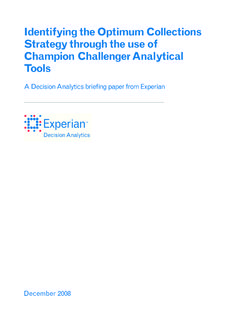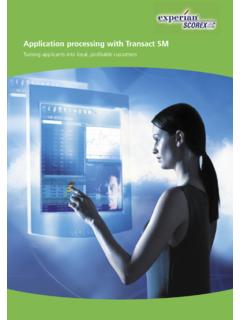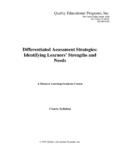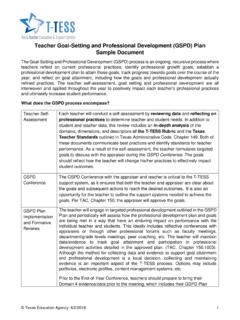Transcription of Experian Collections Strategies
1 Guide One: Maximising the performance of strategiesExperian Collections Strategies July 2010 Quick wins in Collections : Decisioning Strategies 1. Executive SummaryAs lenders are currently experiencing increased levels of bad debt and credit losses, the temptation to adopt a broad, hard line approach to arrears management can be strong. As the first in a series of expert guides to quick wins in Collections , we begin our focus on maximising the effectiveness of Collections Strategies and explain why one size does not need to fit all, even for a niche category of the guides, we examine over 20 different Strategies that organisations can adopt, often for little cost and, using their existing systems, to create more proactive, tailored treatment paths - which will in turn boost Collections performance, deliver efficiencies and drive revenue growth. Quick wins in Collections : Decisioning Strategies Quick wins in Collections : Decisioning Strategies ContentsQuick wins in Collections : Decisioning Strategies the performance of groups need different time (non sufficient funds) Collections -revolving segmentation criteria of balance at risk ( or $ at risk) telephone/bad wins in Collections : Decisioning Strategies 2.
2 Introduction 4 The number of Collections Strategies available to lenders is theoretically unlimited. The key is to determine which Strategies and treatment paths are the most relevant, and will yield the best results, for the business. Achieving the best results however, is not just about driving down delinquency levels. In such a tough operating environment all lenders acknowledge that they will have to strike a fine balance. They need to carefully weigh the principles of credit risk against the potential to maintain or generate ongoing customer value. Collections Strategies and actions must be mindful to not alienate potentially profitable customers who may be going through a temporary period of financial hardship. Successfully rehabilitated customers will be an essential source of future revenue, thus contributing to overall profit experience in many markets around the world has allowed us to identify the most effective Collections Strategies for today s economic climate; Strategies that will proactively accelerate treatments for high risk accounts while ensuring that valuable low risk customers are able to self cure.
3 Not intended as an exhaustive list, these recommendations can be used together or singularly. Depending on the sophistication of the Collections operation, some of these may be in place already, but when did you last review them?As economic conditions change, so too should Collections treatment paths. While implementing the appropriate Collections strategy today is vitally important, there are also various options available to help lenders continually refine those Strategies to achieve optimal performance and significantly bolster the bottom line. These factors will be considered in forthcoming guides, with the aim that all four guides piece together to offer a rounded, conclusive assessment of best practice Collections Strategies . It is important to note that there is an underlying fundamental assumption throughout each guide that organisations have invested in maintaining strong and accurate records, where data quality is recognised as a key ingredient for successful delivery of each strategy.
4 There is an onus on all organisations to maintain the quality of data throughout the customer lifecycle in order to ensure customer management and collection activities are wins in Collections : Decisioning Strategies 53. Maximise the performance of The following Strategies will be used by the majority of Collections operations, determining the timing, channel and specific activity for a particular group of customers. However, the granularity of segmentation and the precision with which action paths are determined are both critical to the success of the strategy. This section explores how different types of customers can be finely segmented to allow the most relevant action paths to be Different groups need different strategiesThe self cure conceptThrough the application of behaviour scoring or balance and behaviour score, and other variables, Strategies can be devised and segmentation applied that will identify those groups most likely to self cure, make a payment without requiring reminders or Collections actions.
5 Highly segmented Strategies can then be implemented that will delay Collections activity on certain groups where there is a higher likelihood of repayment or self : Collections costs in early stage delinquency can be dramatically reduced as actions are targeted towards the delinquent accounts identified as having the lowest likelihood of self-curing. An additional benefit in self cure is the potential for increased levels of customer satisfaction as a result of removing Collections treatments from the low risk groups identified as most likely to pay. strategiesThe above graph provides an illustration of pay down curves for five score wins in Collections : Decisioning Strategies Young accountsAccounts less than six months old are inherently risky due to the lack of robust behavioural and payment history data. New credit cards in particular have a higher chance of being used for fraudulent activity or by consumers who draw down all available funds immediately yet have no intention of meeting payment obligations.
6 However, the acquisition and extension of credit to new customers will be a key element of most lender s future growth plans, and new, potentially profitable customers should not be alienated accounts are often segmented out of the standard Collections process into a separate process for differing treatment. As they will typically not have a robust behavioural score, this group can be segmented by credit bureau score, application score or by balance to separate out those with large need to be put in place that can proactively monitor spending activity and payment schedules from the outset. Young accounts showing moderate to high credit risk need to be isolated and moved to accelerated treatment paths immediately upon missed payment. Value: Welcome pack and /or phone calls to new customers just before first payment have been shown to prevent many first time delinquents and provide education about credit responsibilities and financial obligations.
7 Early gentle reminders to those with moderate credit risk have also been shown to reduce roll rates while still maintaining a positive relationship. For those high risk accounts, the early adoption of more severe tactics such as the reduction, or removal, of available credit will help mitigate credit losses. Early direct telephone contact can be used to secure payments and will reduce charge First time delinquentA similar, but more encompassing strategy should be adopted for accounts that miss their first contractual payment and do actually become delinquent after one cycle. Failing to meet the first payment is a critical risk sign, where again a lack of payment history will weaken a behavioural score. First payment defaults can indicate a potentially fraudulent account, but also first time default can reflect a lack of understanding about credit, or a problem with automatic payment processing.
8 In some markets fraudsters are aware of a lender s typical response to a first payment default and as fraudsters change their behaviours, making the initial payment on time, so some lenders are segmenting second payment defaults for specific and tailored payment delinquents should be isolated for special treatment and contact with the customer made immediately to understand and treat the specific customer situation. These actions are predominantly aimed at accelerating actions in order to identify and address non-payment issues but may, on occasion, simply identify a failure in the account set up process, customer details were incorrectly captured and not validated before setting up a direct debit. (Such issues are usually eliminated where robust automated data capture, verification and validation procedures are adopted.)Value: Quickly identifying and contacting first time defaulters gives lenders the opportunity to rectify direct debit or other payment errors and educate groups less familiar with the credit or instalment repayment process.
9 Fraud can be quickly identified and further losses Habitual delinquentsHabitual delinquents are accounts that are frequently in and out of delinquency, have come to know the standard treatment and tend to use that knowledge to play the system . In other instances customers use the first actions within the collection process to prompt payment rather than paying in a timely manner in accordance with the account terms and the characteristics of a habitual delinquent are defined, a variable can be populated within the Collections or decisioning system which will quickly identify such accounts which are then isolated and a differential treatment path : Improved days sales outstanding (DSO) and cash flow from reducing the number of habitual delinquent accounts. Cost benefits will also be recognised through eliminating recurring and similar treatments to this customer NSF (non sufficient funds)An NSF account is an obviously high risk account, where an automated payment has been rejected or cheque has bounced due to insufficient funds in the variable can be populated within the collection system or decisioning engine to identify these accounts.
10 A Collections strategy is then implemented that will isolate the account and differentiate : With immediate identification and appropriate treatment of these high risk accounts the likelihood of recouping the missed payment is increased. Together with more rapid action the extension of further credit can be removed therefore reducing further wins in Collections : Decisioning Strategies Broken promisesCustomer rehabilitation is commonly achieved through the use of payment arrangements. A promise to pay may be made by a customer during a telephone conversation with Collections staff or perhaps as a result of a letter sent to the customer. The promise made will be for an agreed payment amount at an agreed date in the future. A broken promise is when the delinquent customer does not pay the agreed amount at the agreed point in time. Typically before a promise is deemed to have been broken a tolerance will have been applied in respect of the timing ( one or two days) together with a tolerance set against the payment amount ( a payment of at least 95% of the agreed amount may be sufficient to be considered as a full payment).















